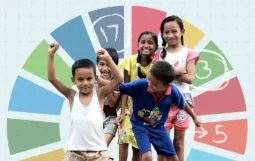Increasing access to medicines to support Universal Health Coverage

During the UN General Assembly this month and going forward, progress towards delivering Universal Health Coverage (UHC) will be front of stage. Achieving UHC was a commitment made as part of the 2030 Sustainable Development Goals (SDGs) when adopted in 2015 – so this year marks the half-way point in the journey towards 2030.
If UHC is defined as ensuring all people have access to the full range of quality health services they need, when and where they need them, without financial hardship, then ensuring patients can have access to the medicines and vaccines must be core to success. IFPMA and its members are working towards the vision in the SDGs and UHC and are convinced that that delivery on this ambition will require actions and partnerships between public and private sectors as well as non-governmental organizations.
Going forward, all stakeholders will need to redouble their efforts if Low and Lower-Middle Income Countries (LLMICs) are going to attain the SDG goals. As part of this much needed focus, pharmaceutical companies, directly or through partnerships, are using a range of initiatives to accelerate patient access to medicines and vaccines. Tools such as tiered pricing, voluntary licensing, sustainable capacity building and value-based healthcare are all delivering for patients across the globe.
Initiatives supporting access
It’s clear that the price of a medicine must be affordable for healthcare systems, whilst recognizing the value that this medicine brings to patients and society. This balance must also consider how to incentivize R&D investment into the next generation of medicines and vaccines.
To get this right, tiered pricing can be one of the most effective and sustainable ways in which pharmaceutical companies can improve access to medicines in LLMICs. While the specifics vary between companies and products, tiered pricing is now a standard approach across the industry, in which prices broadly reflect a country’s relative level of wealth.
Indeed tiered pricing was central to how companies approached delivering vaccines and treatments during the COVID-19 pandemic, where vaccines were delivered on a non-profit basis and at significantly reduced prices to both Gavi, COVAX and other procurers for LLMICs. Many companies have frameworks to make medicines and vaccines available to LLMICs on a tiered pricing basis. For example, Pfizer’s Accord for a Healthier World commits to make its full portfolio of about 500 products available on a not-for-profit basis in 45 LLMICs.
But companies are now looking to go further. New approaches to value-based healthcare (VBHC) and managed entry agreements are increasingly putting the patient and meaningful clinical outcomes at the center, supporting health systems to allocate resources efficiently. For example, Takeda has partnered with the United Nations Institute for Training and Research (UNITAR), which founded a Global VBHC Hub to help governments and health care professionals in LLMICs understand the benefits of shifting to a value-based approach.
Voluntary licensing, partnerships and donation models are having an impact
In some cases, companies license a medicine or vaccine on a voluntary basis to improve its availability and affordability. Licenses can be agreed bilaterally between companies or via the Medicines Patent Pool (MPP) to multiple companies. The voluntary nature of these partnerships enable companies to work together based on the right expertise and experience. The MPP license of an oncology medicine from Novartis in 2022 within the Access to Oncology Medicines (ATOM) partnership, was the first such license in NCDs. Both Gilead and ViiV have been involved in licensing HIV medicines to generic manufacturers for nearly two decades, enabling millions of HIV patients around the world to access the medicines they need.
Donations are often viewed as useful short-term measures that provide access to medicines, for example during a humanitarian crisis, they are rarely considered a sustainable approach long-term. There are important exceptions however: Lilly’s insulin Life for a Child partnership has been running since 2009, and seeks to provide holistic access to care to children with diabetes in developing countries. Lilly is the sole provider of insulin to the partnership and has made strategic commitments until 2030. Another example is MSD’s long term partnership program of Mectizan for river blindness, already in its 35th year. By the end of 2022, the program had shipped five billion treatments, with one billion Mectizan tablets shipped during that year. Excitingly, Niger is on its way to becoming the first country in Africa to ask the WHO to verify that transmission of river blindness has been eliminated.
Looking beyond affordability to achieve UHC
But it would be wrong to assume that tailored approaches to pricing alone can address barriers to patient access to new medicines and vaccines and therefore the journey towards UHC. Systematic barriers within healthcare systems including a lack of healthcare infrastructure and the need for the right, skilled workforce are two key areas where action is needed.
To understand these systemic issues in a bit more detail, Novartis partnered with Boston University to assess its programs in Kenya, which aimed to expand access to medicines in the country. Even when medicines were priced at 1 USD per month, the program “did not affect medicine availability at patient households.” Recommendations from the study include tailoring programs to meet countries’ regulatory schemes, institutional capacities, disease burdens, and financial resources, and in the case of breast cancer, “secondary and tertiary health facilities” were key to distribute medications, as those facilities are often where cancer patients are diagnosed and treated.
The study showed that we must also strengthen local healthcare systems, including educating and training healthcare workers and ensuring that adequate facilities are available for urgent and preventive care within a reasonable travel distance. Strengthening local healthcare systems, including the educating and training of healthcare workers, requires investment. Since 2017, Access Accelerated, a collective initiative of leading biopharmaceutical companies, has sought to address this through a partnership with the World Bank. The partnership has resulted in the mobilization of nearly $3.7bn in the last 3 years alone, targeted at supporting LLMICs to improve the prevention, treatment and care of people living with NCDs.
Furthermore, as part of the UHC2030 partnership, the pharmaceutical industry is committed to partnering with governments and civil society to help LLMICs develop healthcare and financial systems that will ensure better access to medicines and vaccines.
Ensuring patients can access the medicines and vaccines they need must remain central to delivering our ambitions for Universal Healthcare Coverage. But whilst pharmaceutical companies continue to push ahead with their own commitments towards UHC through new approaches to pricing and access, it will be the success of partnership approaches designed to strengthen healthcare systems in LLMICs that will ultimately dictate our collective success in 2030.
Author






